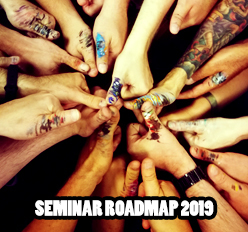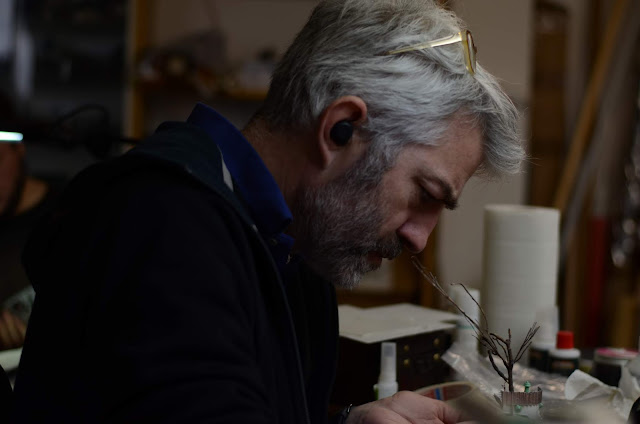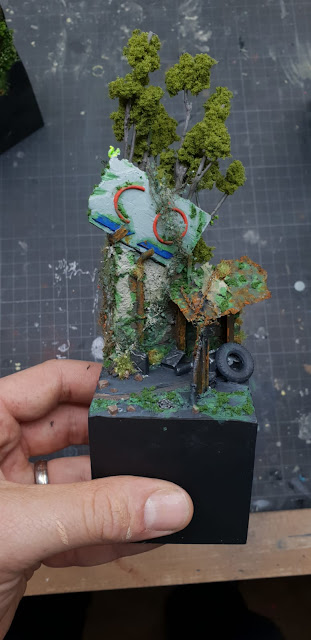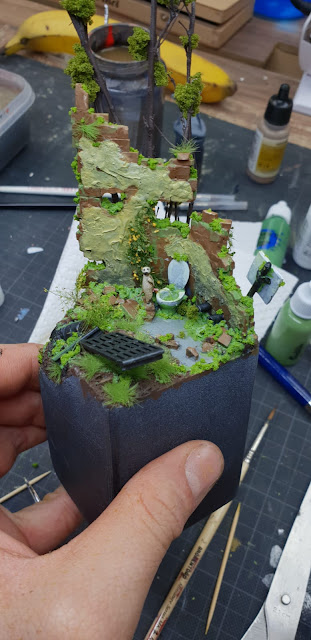Good Morning Jungle,
time to get back to some reviews again.
Christoph visited me for a two day private coaching earlier this year. I know Christoph since several years as a long time student and I do call him a friend. So I was happy that he approached me with a really interesting topic for his two day coaching:
Concepts!
A concept is something like a sketch of an idea. Just like in traditional art forms.
In terms of miniature projects it helps to understand, plan and execute an idea of a project and we all know: Sometimes you just have too many concepts and ideas floating around your head without a real focus.
Christoph's goal with this hands on training was to bring tons of projects and talk with me through their concepts to define them better and even start some of them.
Me & Christoph
Welcome to the MV Studio:

In the first moment I was overwhelmed by the projects Christoph carried up to the MV studio. Mostly basing concepts, but quite the number.
We talked our way into the topic and made a plan on how and when to tackle which concept due its complexity and varity. We decided to go through the easier/faster ones on the first day.
Here is an example on how we tackled a concept:
 Christoph really wanted to create something with these old GW Space Marines. A throne room with many aspects, but he was quitee unsure on its size and base look.
Christoph really wanted to create something with these old GW Space Marines. A throne room with many aspects, but he was quitee unsure on its size and base look.So we talked about simpler ideas:

And via the knowledge Christoph already recieved by being a student in my basing class once we came up with this - optimized his idea:
This is how concepting works. We did many more ... for examply on these old Ilyad Games Wardancers:
Next was a little Panda on his training ground:
We did not finish the concept, but pushed it forward to make it visible ...
Some concepts found different solutions in our talks and brainstorms and we needed to sketch ideas:


On some we worked on to bring them to a point ...

... to catch the idea:

On the second day we tackled two big ideas and talked them through. First there is always the inspiration, then comes the idea, then comes forming this idea into several versions and then it is about to decide which road to take. Concept-wise and material-wise ...
As Christoph is a big Ilyad Games fan and also loves the comics of the "Chronicles of the Black Moon" these two big projects were heavily inspried by the comics.


Working on so many concepts is not doable without taking proper notes ... you can not imagine how many questions arise if two brains get together to optimize a vision/idea. A lot of deep talks about "whys", "feelings", basing harmony and material that could be used ...
Size and scale-fit matters ...
Every angle counts ...
I can say from my part my brain was melted after these two days :D
We were able to concept our way
through several of Christoph's ideas and he is able to move on at home now. It is always helpful to have a good concept and plan before execution. When the plan and concept works the work itself is smooth.
Of course it can still vary and change on its way, but the big frame of the concept is the important part. It gives you guidelines and you usually do not feel lost anytime.
Christoph's concepts after the two days ...
Thank you
Christoph for joining up for a private coaching with such an interesting topic.
Thank you for the good chats we had, thank you for your support in my work and passion and your trust in my teachings since so many years.
Always a pleasure!
Keep on happy painting!
Roman
____________________________________________________________________________
Available spots for private coachings in 2019
are already rare. A small number of possible dates do exist. If you are interested in getting your hands on coaching with me going, just write me an email to: jarhead---at---massivevoodoo---dot---com
You can find more information
about upcoming workshops via this banner
about upcoming workshops via this banner
























































































































